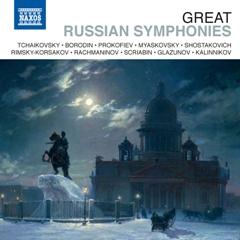Great Russian Symphonies - Vol. 3 (2012)
Great Russian Symphonies - Vol. 3 (2012)

Tchaikovsky, Pyotr Il'yich Symphony No. 6 in B minor, Op. 74, "Pathetique" 1. Andante - Allegro Con Anima 2. Andante Cantabile, Con Alcuna Licenza 3. Valse: Allegro Moderato 4. Finale: Andante Maestoso - Allegro Vivo ---------------------------------------- 5. Romeo and Juliet Fantasy Overture Polish National Radio Symphony Orchestra (1 - 4) Antoni Wit - conductor Pietro Alessandro Guglielmi Chamber Orchestra (5) Adrian Leaper - conductor
Tchaikovsky composed this music between February and August 1893, and conducted the first performance on October 28 of that year in St. Petersburg. Already in 1890 Tchaikovsky had written to his patroness of 13 years, Nadezhda von Meck, about a possible "program symphony." By 1893 he was ready to follow through on the idea, dedicated to his nephew Vladimir Davidov, the "Bobyk" (or "Bob") of many diary-entries and letters during the 1880s. After a successful premiere, however, he was not satisfied with Program Symphony (No. 6) on the title page. Several days later Modest suggested "patetichesky," which in Russian means "1, enthusiastic, passionate; 2, emotional; and 3, bombastic" (rather than "pathetic" or "arousing pity," as in English). Pyotr Il'yich was delighted by the suggestion: "Excellent, Modya, bravo, patetichesky!" He wrote this onto the score, and sent it the same day to his publisher, Jurgenson. Two days later, however, he had qualms and asked Jurgenson to suppress subtitles -- to issue the work simply as Symphony No. 6, dedicated to Bobyk. One week later, he was dead. As for Jurgenson, he could not resist the opportunity in 1893 to publish No. 6, in elegant Lingua Franca, as Symphonie pathétique. The sobriquet has stuck ever since.
During the work's incubation Tchaikovsky was in rare good spirits, pleased with his boldness and fluency, especially in the trailblazing finale, a drawn-out Adagio of funereal character. Where others still wrote conventional slow movements, he hit on the idea of "a limping waltz" in 5/4 time. And he made the scherzo a march that builds to such a pitch of excitement that audiences ever since, everywhere, applaud at the end.
A lugubrious Adagio prologue begins with a bassoon solo in E minor that makes its way upward through the murk of divisi string basses, followed by a nervous little motif that blossoms into the main theme of an Allegro ma non troppo sonata-structure in B minor. The memorably sighing, mauve-hued melody that dominates this movement is actually its secondary subject. A crashing orchestral tutti sets up the passionately agitated development section, followed by a condensed reprise and a brief, calmed coda.
Tchaikovsky's marking for this D major "waltz" movement is Allegro con grazia -- a song and trio with extended coda whose mood may be wistful, even melancholic midway, but whose spirit is balletic, to the extent of echoing Nutcracker's "Waltz of the Flowers," composed a year earlier.
The March-Scherzo, Allegro molto vivace in common time, has an elfin character at the start. It is a sonatina (exposition and reprise without development) that quick-steps to an explosive climax but always returns to tonic G major.
Another sonatina (symphonic developments were Tchaikovsky's bête noire) is anchored in B minor, although the tragic second theme enters in D major. The overall mood is inconsolably grieving, but not "pathetic." Ultimately, the music returns to those murky depths in which the symphony was born some 40 minutes earlier -- without, however, benediction or hope. ---Roger Dettmer, allmusic.com
Mily Balakirev was a well-established founding father of Russian Nationalism in the late 1860s when he recognized a potential new protégé in the young Tchaikovsky. Balakirev’s influence had begun to diminish over the previous years but his helpful and discerning eye was just the sort of validation Tchaikovsky needed at the time. When Balakirev proposed a musical fantasy setting of Shakespeare’s tragic Romeo and Juliet in 1869, Tchaikovsky (a tortured soul even then) took to the agonizing subject matter in earnest. The dramatic events of Romeo and Juliet the play have elicited several legendary musical responses over time. Berlioz, Prokofiev and even Leonard Bernstein crafted masterful scores that perfectly captured the broad-stroke emotional content of Shakespeare’s words and Tchaikovsky’s “fantasy overture,” though more brief in scope, is their equal (if not superior) in every regard. This was the first great thunderbolt to issue from Tchaikovsky’s pen and the best early realization of his incredible potential. The boiled down story of the overture careens between the tension of the clashing Montague and Capulet houses and the heartbreaking beauty of the protagonists’ love. The sum of the parts is pure magic. Tchaikovsky revised the score twice over the next decade, once in 1870 at the suggestion of Balakirev and again in 1880. Thought the original version is a masterpiece in its own right, it was the final revision that the composer himself blessed as definitive. ---utahsymphony.org
download (mp3 @320 kbs):
yandex mediafire uloz.to cloud.mail.ru gett








